Synthesis, Crystal Structure, Spectral Characterization and Antifungal Activity of Novel Phenolic Acid Triazole Derivatives
Abstract
:1. Introduction
2. Results
2.1. Chemistry
2.2. FT-IR Spectral Characterization
2.3. NMR Spectral Characterization
2.4. Crystal Structures of Compounds 1a–3a and 3b
2.4.1. Crystal Structure of Compound 1a
2.4.2. Crystal Structure of Compound 2a
2.4.3. Crystal Structure of Compound 3a
2.4.4. Crystal Structure of Compound 3b
2.5. Antifungal Activity Analysis
3. Discussion
4. Experimental Procedure
4.1. Materials and Methods
4.2. Synthesis of 3a–3c
4.2.1. Synthesis of Compounds 1a–1c
4.2.2. Synthesis of Compounds 2a–2c
4.2.3. Syntheses of Compounds 3a–3c
- Methyl 4-(2-bromoethoxy) benzoate (1a): white solid; the yield is 35.8%, m. p: 63.4~65.0 °C. 1H NMR (500 MHz, CDCl3) δ 8.00 (d, J = 8.8 Hz, 2H), 6.93 (d, J = 8.8 Hz, 2H), 4.34 (t, J = 6.2 Hz, 2H), 3.89 (s, 3H), 3.66 (t, J = 6.2 Hz, 2H). 13C NMR (126 MHz, CDCl3) δ 166.91, 161.99, 131.90, 123.55, 114.43, 68.04, 52.13, 28.82. HRMS: C10H11BrO3 for [M + H]+, calculated 258.9925, found 258.9960.
- Methyl 4-(2-bromoethoxy)-3-methoxybenzoate (1b): white solid; the yield is 40.2%, m. p: 69.6~72.1 °C. 1H NMR (500 MHz, CDCl3) δ 7.65 (d, J = 10.3 Hz, 1H), 7.57 (s, 1H), 6.90 (d, J = 8.4 Hz, 1H), 4.38 (t, J = 6.7 Hz, 2H), 3.92 (s, 3H), 3.90 (s, 3H), 3.68 (t, J = 6.7 Hz, 2H). 13C NMR (126 MHz, CDCl3) δ 166.68, 151.39, 149.13, 123.75, 123.26, 112.88, 112.63, 68.75, 56.14, 52.04, 28.29. HRMS: C11H13BrO4 for [M + H]+, calculated 289.0031, found 289.0072.
- Methyl 4-(2-bromoethoxy)-3,5-dimethoxybenzoate (1c): white solid; the yield is 36.7%, m. p: 102.1~103.5 °C. 1H NMR (500 MHz, CDCl3) δ 7.29 (s, 2H), 4.34–4.29 (m, 2H), 3.93 (s, 3H), 3.92 (s, 6H), 3.63–3.58 (m, 2H). 13C NMR (126 MHz, CDCl3) δ 166.58, 152.91, 140.35, 125.69, 106.69, 72.56, 56.24, 52.25, 29.47. HRMS: C12H15BrO5 for [M + H]+, calculated 319.0136, found 319.0170.
- Methyl 4-(2-(1H-1,2,4-triazol-1-yl) ethoxy) benzoate (2a): white solid; the yield is 62.5%, m. p: 113.5~116.1 °C. 1H NMR (500 MHz, CDCl3) δ 8.22 (d, J = 9.0 Hz, 2H), 7.98 (s, 1H), 7.97 (d, J = 3.2 Hz, 1H), 6.87 (d, J = 8.8 Hz, 2H), 4.60 (t, J = 5.0 Hz, 2H), 4.39 (t, J = 5.0 Hz, 2H), 3.88 (s, 3H). 13C NMR (126 MHz, CDCl3) δ 166.82, 161.43, 152.14, 143.96, 131.69, 123.58, 114.06, 65.64, 51.95, 49.07. HRMS: C12H13N3O3 for [M + H]+, calculated 248.0990, found 248.1028.
- Methyl 4-(2-(1H-1,2,4-triazol-1-yl)ethoxy)-3-methoxybenzoate (2b): white solid; the yield is 65.6%, m. p:118.3~120.4 °C. 1H NMR (500 MHz, DMSO) δ 8.55 (s, 1H), 7.99 (s, 1H), 7.55 (d, J = 8.4 Hz, 1H), 7.45 (s, 1H), 7.08 (d, J = 8.5 Hz, 1H), 4.62 (t, J = 5.1 Hz, 2H), 4.43 (t, J = 5.1 Hz, 2H), 3.81 (s, 3H), 3.78 (s, 3H). 13C NMR (126 MHz, DMSO) δ 165.83, 151.50, 151.42, 148.57, 144.63, 122.99, 122.50, 112.70, 112.23, 66.54, 55.71, 51.91, 48.23. HRMS: C13H15N3O4 for [M + H]+, calculated 278.1096, found 278.1125.
- Methyl 4-(2-(1H-1,2,4-triazol-1-yl)ethoxy)-3,5-dimethoxybenzoate (2c): white solid; the yield is 59.8%, m. p: 88.1~89.6 °C. 1H NMR (500 MHz, DMSO) δ 8.60 (s, 1H), 8.04 (s, 1H), 7.27 (s, 2H), 4.54 (t, J = 5.0 Hz, 2H), 4.37 (t, J = 5.0 Hz, 2H), 3.91 (s, 3H), 3.84 (s, 6H). 13C NMR (126 MHz, DMSO) δ 165.71, 152.53, 151.15, 144.62, 140.01, 124.98, 106.22, 70.52, 55.95, 52.18, 49.24. HRMS: C14H17N3O5 for [M + 1], calculated 308.1202, found 308.1215.
- 4-(2-(1H-1,2,4-triazol-1-yl) ethoxy) benzoic acid (3a): white solid; the yield is 84.8%, m. p: 194.3~197.5 °C. 1H NMR (500 MHz, DMSO) δ 12.64 (s, 1H), 8.58 (s, 1H), 7.99 (s, 1H), 7.87 (d, J = 8.7 Hz, 2H), 7.00 (d, J = 8.8 Hz, 2H), 4.61 (t, J = 5.0 Hz, 2H), 4.43 (t, J = 5.0 Hz, 2H). 13C NMR (126 MHz, DMSO) δ 166.84, 161.41, 151.49, 144.68, 131.31, 123.41, 114.31, 65.87, 48.18. HRMS: C11H11N3O3 for [M + H]+, calculated 234.0834, found 234.0859.
- 4-(2-(1H-1,2,4-triazol-1-yl) ethoxy)-3-methoxybenzoic acid (3b): white solid; the yield is 82.1%, m. p: 178.3~180.2 °C. 1H NMR (500 MHz, DMSO) δ 12.70 (s, 1H), 8.54 (s, 1H), 7.98 (s, 1H), 7.52 (d, J = 10.2 Hz, 1H), 7.44 (s, 1H), 7.05 (d, J = 16.2 Hz, 1H), 4.62 (t, J = 5.1 Hz, 2H), 4.43 (t, J = 5.1 Hz, 2H), 3.77 (s, 3H). 13C NMR (126 MHz, DMSO) δ 166.92, 151.39, 151.15, 148.49, 144.60, 123.74, 123.01, 112.67, 112.53, 66.54, 55.64, 48.24. HRMS: C12H13N3O4 for [M + H]+, calculated 264.0940, found 264.0946.
- 4-(2-(1H-1,2,4-triazol-1-yl) ethoxy)-3,5-dimethoxybenzoic acid (3c): white solid; the yield is 80.2%, m. p: 168.5~171.7 °C. 1H NMR (500 MHz, DMSO) δ 8.54 (s, 1H), 7.96 (s, 1H), 7.19 (s, 2H), 4.46 (t, J = 5.0 Hz, 2H), 4.28 (t, J = 5.0 Hz, 2H), 3.74 (s, 6H). 13C NMR (126 MHz, DMSO) δ 167.05, 152.42, 151.19, 144.70, 139.49, 127.01, 106.37, 70.55, 55.92, 49.34. HRMS: C13H15N3O5 for [M + H]+, calculated 294.1045, found 294.1055.
4.3. Crystal Structure Determination
4.4. Antifungal Activity Test
5. Conclusions
Supplementary Materials
Author Contributions
Funding
Institutional Review Board Statement
Informed Consent Statement
Data Availability Statement
Acknowledgments
Conflicts of Interest
Sample Availability
References
- Yi, J.P.; He, J. Principle, Diagnosis and Treatment of Common Plant Diseases, 1st ed.; China Agricultural University Press: Beijing, China, 2012. [Google Scholar]
- Wang, H.; Gao, X.; Zhang, X.; Jin, H.; Tao, K.; Hou, T. Design, synthesis and antifungal activity of novel fenfuJram-diarylamine hybrids. Bioorg. Med. Chem. Lett. 2017, 27, 90–93. [Google Scholar] [CrossRef]
- Qi, L.; Li, M.C.; Bai, J.C.; Ren, Y.H.; Ma, H.X. In vitro antifungal activities, molecular docking, and DFT studies of 4-amine-3-hydrazino-5-mercapto-1,2,4-triazole derivatives. Bioorg. Med. Chem. Lett. 2021, 40, 127902. [Google Scholar] [CrossRef] [PubMed]
- Hou, J.; Liang, L.; Su, M.; Yang, T.; Mao, X.; Wang, Y. Variations in phenolic acids and antioxidant activity of navel orange at different growth stages. Food Chem. 2021, 360, 129980. [Google Scholar] [CrossRef] [PubMed]
- Hssaini, L.; Hernandez, F.; Viuda-Martos, M.; Charafi, J.; Razouk, R.; Houmanat, K.; Ouaabou, R.; Ennahli, S.; Elothmani, D.; Hmid, I.; et al. Survey of Phenolic Acids, Flavonoids and In Vitro Antioxidant Potency Between Fig Peels and Pulps: Chemical and Chemometric Approach. Molecules 2021, 26, 2574. [Google Scholar] [CrossRef] [PubMed]
- Lee, T.K.; Kang, I.J.; Kim, B.; Sim, H.J.; Kim, D.W.; Ahn, J.H.; Lee, J.C.; Ryoo, S.; Shin, M.C.; Cho, J.H.; et al. Experimental Pretreatment with Chlorogenic Acid Prevents Transient Ischemia-Induced Cognitive Decline and Neuronal Damage in the Hippocampus through Anti-Oxidative and Anti-Inflammatory Effects. Molecules 2020, 25, 3578. [Google Scholar] [CrossRef] [PubMed]
- Luo, Y.; Lai, C.J.S.; Zhang, J.; Feng, Y.; Wen, Q.; Tan, T. Comprehensive metabolic profile of phenolic acids and flavonoids in Glechomae Herba using ultra-high-performance liquid chromatography coupled to quadrupole-time-of-flight tandem mass spectrometry with diagnostic ion filtering strategy. J. Pharm. Biomed. Anal. 2018, 164, 615–629. [Google Scholar] [CrossRef] [PubMed]
- Liu, J.; Du, C.; Beaman, H.T.; Monroe, M.B.B. Characterization of Phenolic Acid Antimicrobial and Antioxidant Structure–Property Relationships. Pharmaceutical 2020, 12, 419. [Google Scholar] [CrossRef] [PubMed]
- Debjani, G.; Parnajyoti, K. Insight into anti-oxidative carbohydrate polymers from medicinal plants: Structure-activity relationships, mechanism of actions and interactions with bovine serum albumin. Int. J. Biol. Macromol. 2020, 166, 1022–1034. [Google Scholar] [CrossRef]
- Gu, J.; Feng, L.; Song, J.; Cui, L.; Liu, D.; Ma, L.; Jia, X. The effect and mechanism of combination of total paeony glycosides and total ligustici phenolic acids against focal cerebral ischemia. Sci. Rep. 2020, 10, 3689. [Google Scholar] [CrossRef]
- Yuan, Y.; Xiang, J.; Zheng, B.; Sun, J.; Luo, D.; Li, P.; Fan, J. Diversity of phenolics including hydroxycinnamic acid amide derivatives, phenolic acids contribute to antioxidant properties of proso millet. LWT 2022, 154, 112611. [Google Scholar] [CrossRef]
- Przybylska-Balcerek, A.; Szablewski, T.; Cegielska-Radziejewska, R.; Goral, T.; Kurasiak-Popowska, D.; Stuper-Szablewska, K. Assessment of Antimicrobial Properties of Phenolic Acid Extracts from Grain Infected with Fungi from the Genus Fusarium. Molecules 2022, 27, 1741. [Google Scholar] [CrossRef]
- Hassan, M.; Vanjare, B.D.; Sim, K.Y.; Raza, H.; Lee, K.H.; Shahzadi, S.; Kloczkowski, A. Biological and Cheminformatics Studies of Newly Designed Triazole Based Derivatives as Potent Inhibitors against Mushroom Tyrosinase. Molecules 2022, 27, 1731. [Google Scholar] [CrossRef] [PubMed]
- Oukoloff, K.; Lucero, B.; Francisco, K.R.; Brunden, K.R.; Ballatore, C. 1,2,4-Triazolo[1,5-a]pyrimidines in drug design. Eur. J. Med. Chem. 2019, 165, 332–346. [Google Scholar] [CrossRef]
- Liu, X.; Shi, J.; Han, L.; Min, L.; Wang, H.; Yu, C. Synthesis, Cyrstal Structure and Fungicidal Activity of New Triazole Compounds Containing Trifluoromethylphenyl Moiety. Chin. J. Org. Chem. 2021, 41, 4498–4503. [Google Scholar] [CrossRef]
- Yang, L.; Sun, Y.; Lu, Z.; Liang, J.; Wang, T.; Luo, J. Synthesis and herbicidal activity of pyrimidyl-1,2,4-triazole derivatives containing aryl sulfonyl moiety. J. Heterocycl. Chem. 2021, 59, 704–719. [Google Scholar]
- Bębenek, E.; Jastrzębska, M.; Kadela-Tomanek, M.; Chrobak, E.; Orzechowska, B.; Zwolińska, K.; Latocha, M.; Mertas, A.; Czuba, Z.; Boryczka, S. Novel Triazole Hybrids of Betulin: Synthesis and Biological Activity Profile. Molecules 2017, 22, 1876. [Google Scholar] [CrossRef]
- Ji, K.; Zhang, G.N.; Zhao, J.Y.; Zhu, M.; Wang, M.H.; Wang, J.X.; Cen, S.; Wang, Y.C.; Li, W.Y. Design, synthesis, and anti-influenza A virus activity evaluation of novel indole containing derivatives of triazole. Bioorg. Med. Chem. Lett. 2022, 64, 128681. [Google Scholar] [CrossRef]
- Harikrishna, K.; Hua, G.; Fuad, N.; Yogindra, V.; Moonsoo, J.M.; Timothy, D.M.; Behfar, E.; Haluk, B.S.; Oguz, A.; Omer, A.; et al. 18F-Positron Emitting/Trimethine Cyanine-Fluorescent Contrast for Image-Guided Prostate Cancer Management. J. Med. Chem. 2018, 61, 4256–4262. [Google Scholar] [CrossRef]
- Guo, H.Y.; Chen, Z.A.; Shen, Q.K.; Quan, Z.S. Application of triazoles in the structural modification of natural products. J. Enzyme Inhib. Med. Chem. 2021, 36, 1115–1144. [Google Scholar] [CrossRef]
- Kannan, R.; Mamangam, S.; Perumal, R. Synthesis, optical properties, and antioxidant and anticancer activity of benzoheterazole dendrimers with triazole bridging unit. New J. Chem. 2018, 42, 3282–3292. [Google Scholar] [CrossRef]
- Kavita, B.; Vir, S.J.; Aakriti, S.; Arshmeet, K.; Nitish, K.; Kaur, G.H.; Atamjit, S.; Harbinder, S.; Singh, B.P.M. Novel series of triazole containing coumarin and isatin based hybrid molecules as acetylcholinesterase inhibitors. J. Mol. Struct. 2021, 1245, 131085. [Google Scholar] [CrossRef]
- Łukasz, L.; Michał, B.; Ewa, M.; Andrzej, Ł.; Radosław, P.; Jadwiga, T.G. Synthesis and characterization of triazole based nanocrystalline cellulose solid proton conductors. Eur. Polym. J. 2021, 161, 110825. [Google Scholar] [CrossRef]
- Mohamed, K.S.; Elbialy, E.; Fadda, A.A. Application of N-(Aryl)-2-oxo-2-(arylamino)acetohydrazonoyl Cyanide in Synthesis of Some Novel Triazole Derivatives and Their Biological Activity. Russ. J. Gen Chem. 2021, 91, 1592–1603. [Google Scholar] [CrossRef]
- Li, M.C.; Han, Y.Y.; Ren, Y.H.; Yang, B.; Qi, L.; Zhang, W.H. the Synthesis, Antibacterial Activity, and Molecular Docking of Pyrine Structures. Pesticides 2022, 61, 798–802+844. [Google Scholar] [CrossRef]
- Slivka, M.; Fizer, M.; Mariychuk, R.; Ostafin, M.; Moyzesh, O.; Koval, G.; Oksana, H.K.; Rusyn, I.; Lendel, V. Synthesis and Antimicrobial Activity of Functional Derivatives of thiazolo[2,3-c][1,2,4]triazoles. Lett. Drug. Des. Discov. 2022, 19, 791–799. [Google Scholar] [CrossRef]
- Gu, J.; Xiao, P.L.; Wang, J.; Zhong, L.; Nie, X.L.; Peng, D.Y. Synthesis, Crystal Structure, Spectroscopic Characterization and Anti-fungal Activity of Ethyl 2-Oxo-2H-chromene-3-carboxylateDerivatives. J. Mol. Struct. 2022, 1257, 132576. [Google Scholar] [CrossRef]
- Huang, C.X.; Gu, J.; Xiong, W.M.; Chen, J.Z.; Nie, X.L.; Shang-Guan, X.C. Synthesis, Crystal Structures and Antibacterial Activities of Two Complexes of Zn(II)/Cd(II) Assembled by 4-Carboxymethoxycinnamic Acid Ligand. Chin. J. Inorg. Chem. 2021, 37, 1197–1203. [Google Scholar] [CrossRef]
- Zhu, Y.M.; Miao, T.F.; Yang, Y.; Zhuang, D.Y.; Zheng, K.C.; Wong, W.T. Directionality and site selectivity of N⋯Cl halogen bonding in two azaaromatic chloride crystals. J. Mol. Struct. 2010, 975, 274–279. [Google Scholar] [CrossRef]
- Ma, Y.L.; Zhou, R.; Zeng, X.; An, Y.X.; Qiu, S.; Nie, L. Synthesis, DFT and antimicrobial activity assays in vitro for novel cis/trans-but-2-enedioic acid esters. J. Mol. Struct. 2014, 1063, 226–234. [Google Scholar] [CrossRef]
- Bruker. APEX2, SAINT and SADABS; Bruker AXS Inc.: Madison, WI, USA, 2005. [Google Scholar]
- Sheldrick, G.M. A short history of SHELX. Acta Crvstallogr. 2008, A64, 112–122. [Google Scholar] [CrossRef]
- Sheldrick, G.M. Crvstal structure refinement with SHELXL. Acta Crystallogr. 2015, C71, 3–8. [Google Scholar] [CrossRef]
- Gen, Q.C.; Lina, Z.; Jiaxuan, H.; Song, Z.; Yuan, H.L.; Xiaolong, G.; Di, S.; Yuee, T.; Sheng, M.L.; Xiao, B.H.; et al. Combinatorial Synthesis of Novel 1-Sulfonyloxy/acyloxyeugenol Derivatives as Fungicidal Agents. Comb. Chem. High Throughput Screen. 2022, 25, 1545–1551. [Google Scholar] [CrossRef]
- Yao, C.Y.; Liu, C.; Li, X.J.; Bai, J.K.; Xu, M.; Qiu, R.; Chen, Y.G.; Kang, Y.B.; Li, S.J. The screening of the root rot prevention of tobacco sickle bacteria. Chin. J. Henan. Agric. Sci. 2022, 51, 87–94. [Google Scholar] [CrossRef]
- Lei, Y. Design, Synthesis, and antifungal activity of novel benzimidazole derivatives bearing thioether and carbamate moieties. J. Chem. 2022, 8646557. [Google Scholar] [CrossRef]


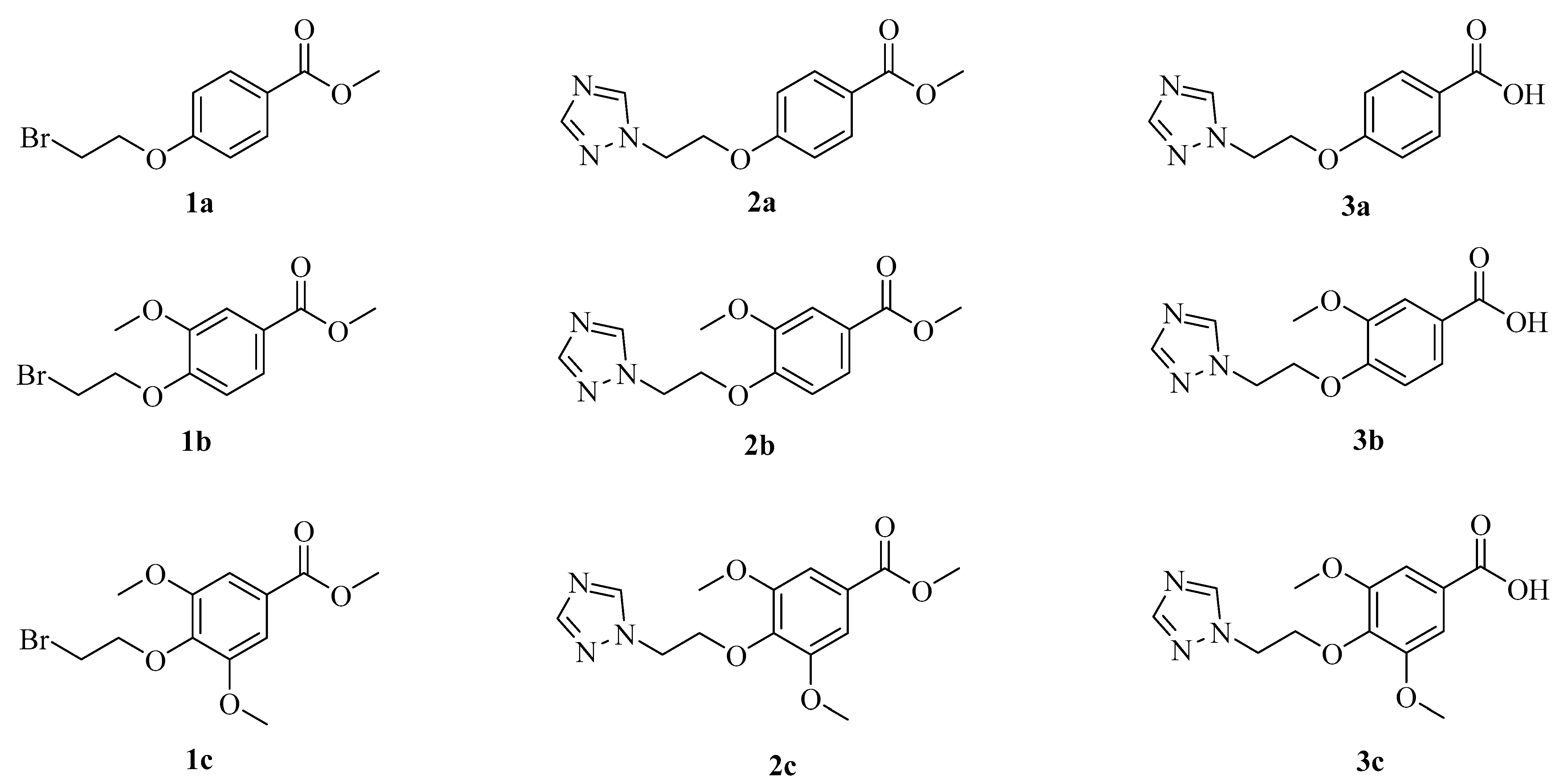

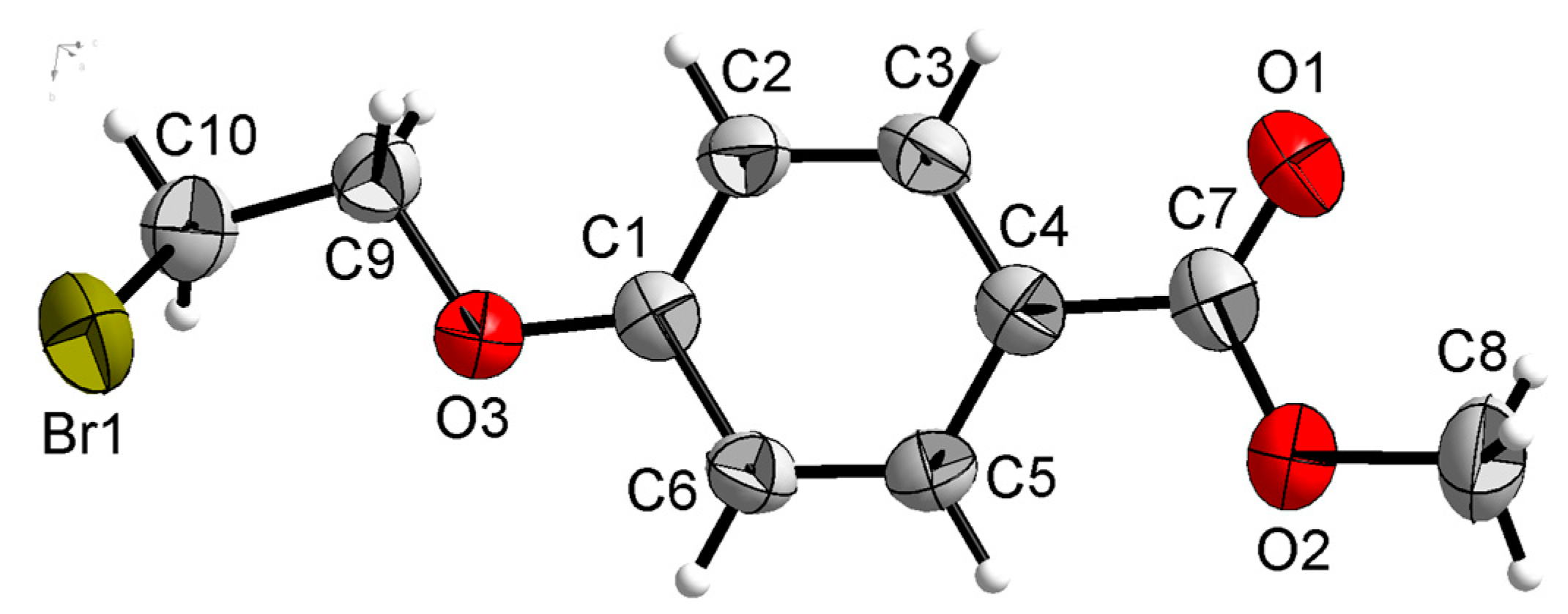
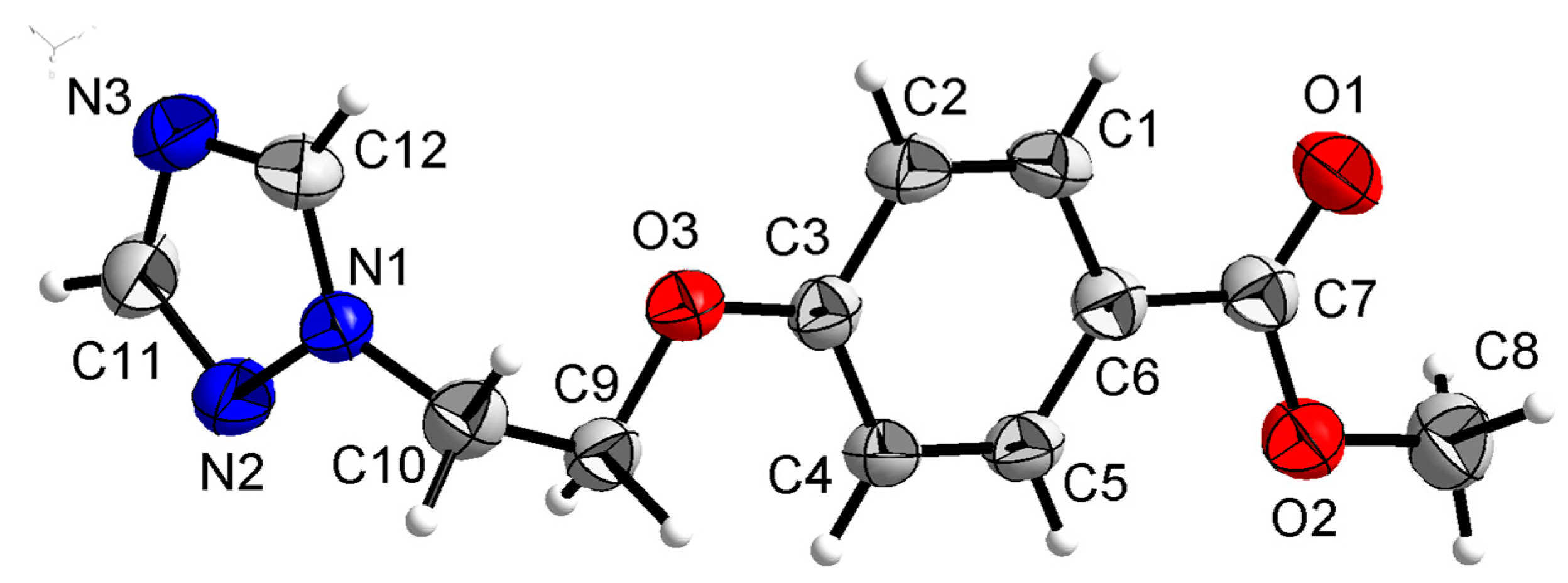


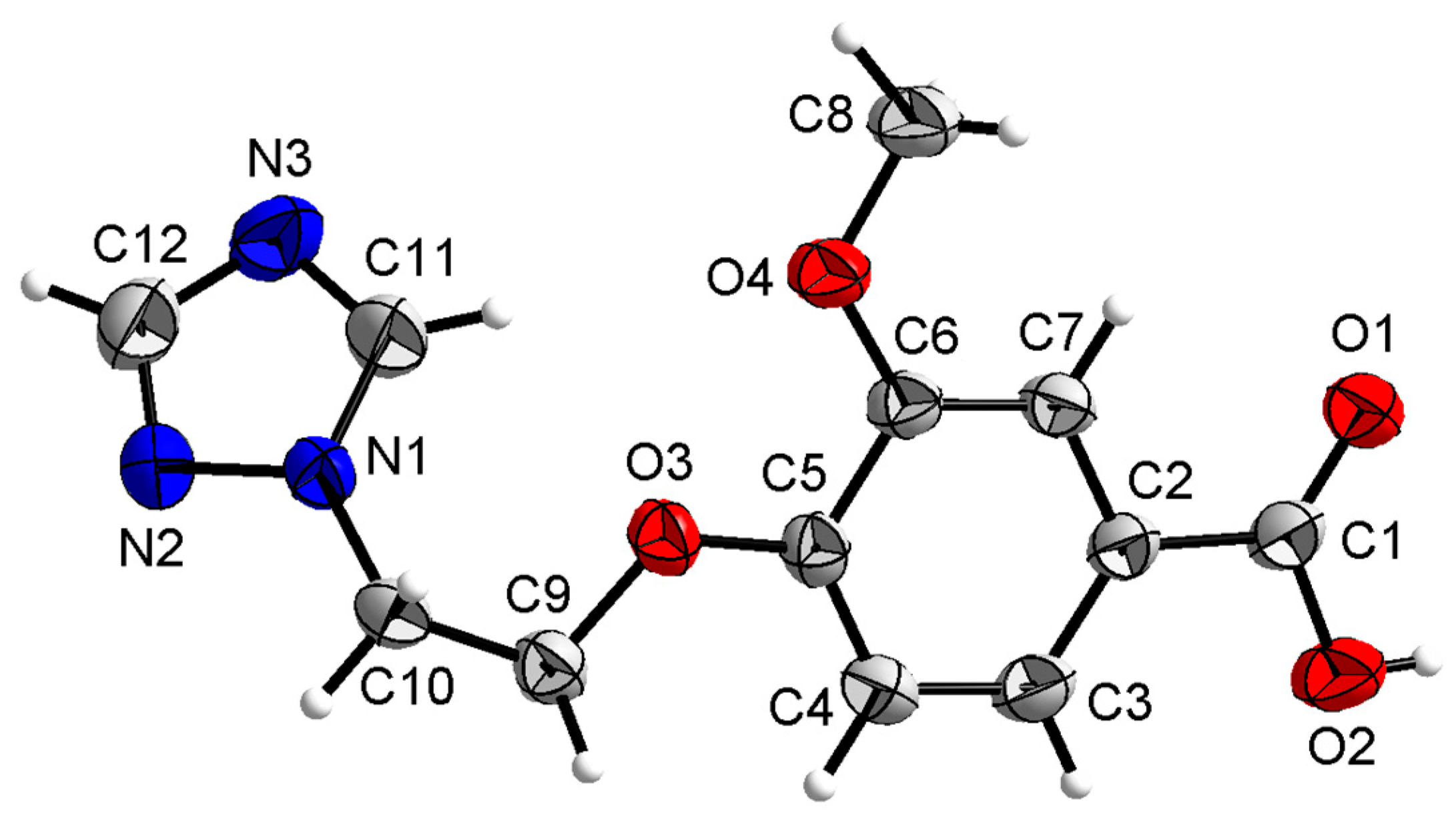

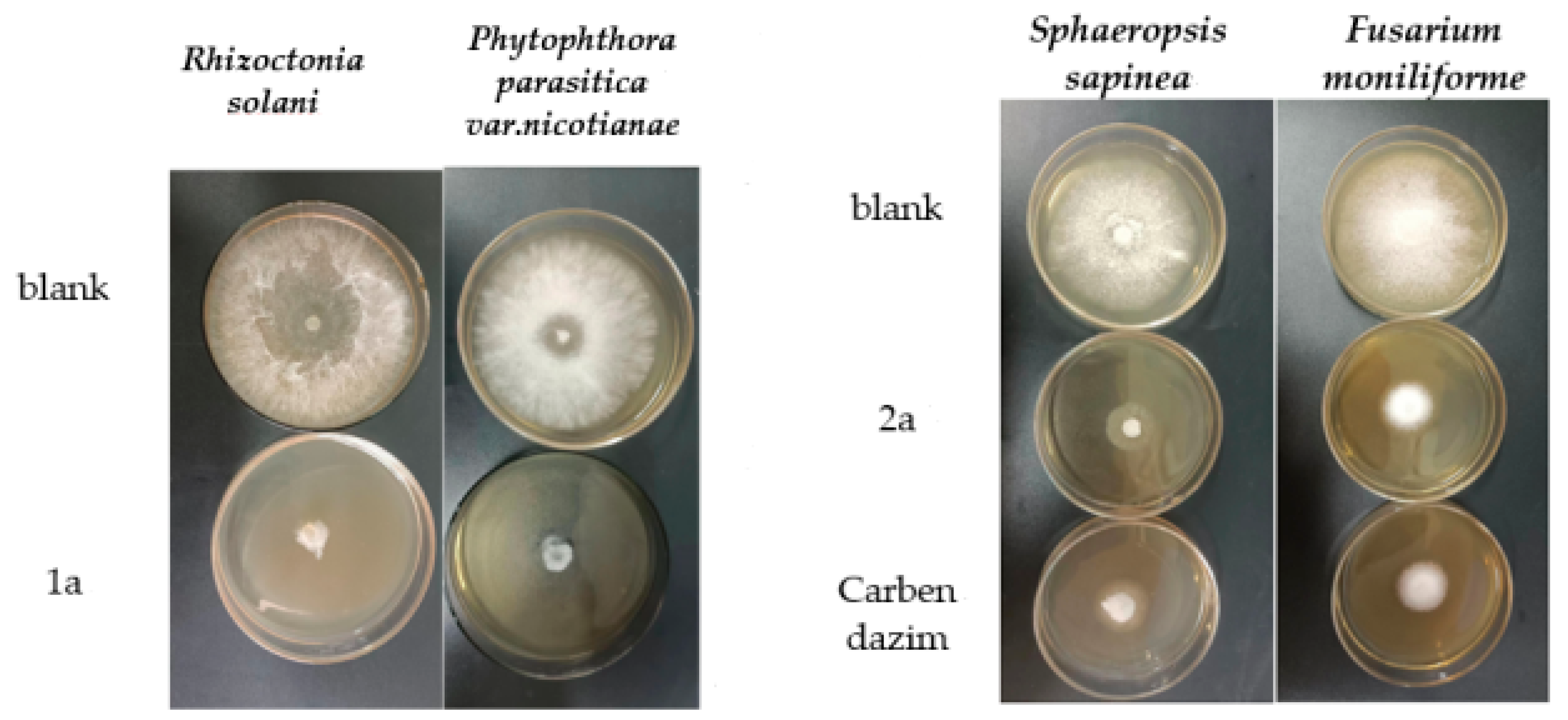
| Compd | Conc (μg/mL) | Inhibition Rate (%) | ||||||
|---|---|---|---|---|---|---|---|---|
| R. S. | F. M. | C. F. | P. P. | F. N. | F. V. | S. S. | ||
| 1a | 100 | 81.6% | 54.3% | 42.3% | 50.2% | 33.1% | 37.7% | 58.2% |
| 200 | 88.6% | 63.5% | 53.9% | 80.7% | 52.1% | 46.7% | 63.2% | |
| 1b | 100 | 48.7% | 24.9% | 44.2% | 24.3% | 28.5% | 21.2% | 34.2% |
| 200 | 68.6% | 44.6% | 57.3% | 31.8% | 37.4% | 38.0% | 49.1% | |
| 1c | 100 | 26.6% | 20.7% | 35.5% | 10.2% | 2.6% | 9.8% | 1.6% |
| 200 | 65.7% | 29.8% | 49.3% | 18.0% | 16.0% | 20.0% | 30.8% | |
| 2a | 100 | 33.8% | 67.1% | 29.3% | 6.3% | 8.5% | 23.3% | 72.2% |
| 200 | 51.7% | 76.1% | 32.8% | 27.5% | 25.6% | 31.2% | 75.4% | |
| 2b | 100 | 15.4% | 3.7% | 24.3% | 12.6% | 4.6% | 8.1% | 11.0% |
| 200 | 42.4% | 26.2% | 45.1% | 15.0% | 21.9% | 14.9% | 28.9% | |
| 2c | 100 | 19.1% | 3.7% | 32.8% | 4.4% | 2.1% | 7.2% | 1.3% |
| 200 | 56.8% | 27.8% | 40.8% | 15.0% | 6.8% | 7.2% | 28.1% | |
| 3a | 100 | 0 | 0 | 0 | 0 | 0 | 0 | 1.0% |
| 200 | 0.7% | 13.4% | 4.2% | 4.0% | 1.4% | 9.7% | 20.5% | |
| 3b | 100 | 0 | 0 | 0 | 0 | 0.4% | 0 | 0 |
| 200 | 0.4% | 23.0% | 0 | 6.6% | 1.4% | 6.2% | 23.4% | |
| 3c | 100 | 0 | 0 | 0 | 0 | 1.3% | 0 | 0 |
| 200 | 0.5% | 20.2% | 3.7% | 0 | 2.4% | 5.7% | 24.3% | |
| CBDZ | 100 | 100% | 53.1% | 100% | 100% | 100% | 100% | 55.2% |
| 200 | 100% | 65.0% | 100% | 100% | 100% | 100% | 63.5% | |
Disclaimer/Publisher’s Note: The statements, opinions and data contained in all publications are solely those of the individual author(s) and contributor(s) and not of MDPI and/or the editor(s). MDPI and/or the editor(s) disclaim responsibility for any injury to people or property resulting from any ideas, methods, instructions or products referred to in the content. |
© 2023 by the authors. Licensee MDPI, Basel, Switzerland. This article is an open access article distributed under the terms and conditions of the Creative Commons Attribution (CC BY) license (https://creativecommons.org/licenses/by/4.0/).
Share and Cite
Xiao, P.-L.; Song, X.-Y.; Xiong, X.-T.; Peng, D.-Y.; Nie, X.-L. Synthesis, Crystal Structure, Spectral Characterization and Antifungal Activity of Novel Phenolic Acid Triazole Derivatives. Molecules 2023, 28, 6970. https://doi.org/10.3390/molecules28196970
Xiao P-L, Song X-Y, Xiong X-T, Peng D-Y, Nie X-L. Synthesis, Crystal Structure, Spectral Characterization and Antifungal Activity of Novel Phenolic Acid Triazole Derivatives. Molecules. 2023; 28(19):6970. https://doi.org/10.3390/molecules28196970
Chicago/Turabian StyleXiao, Pan-Lei, Xiu-Ying Song, Xin-Ting Xiong, Da-Yong Peng, and Xu-Liang Nie. 2023. "Synthesis, Crystal Structure, Spectral Characterization and Antifungal Activity of Novel Phenolic Acid Triazole Derivatives" Molecules 28, no. 19: 6970. https://doi.org/10.3390/molecules28196970
APA StyleXiao, P.-L., Song, X.-Y., Xiong, X.-T., Peng, D.-Y., & Nie, X.-L. (2023). Synthesis, Crystal Structure, Spectral Characterization and Antifungal Activity of Novel Phenolic Acid Triazole Derivatives. Molecules, 28(19), 6970. https://doi.org/10.3390/molecules28196970






